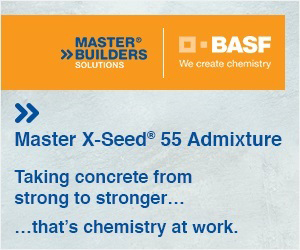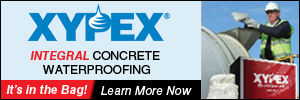 |
||
|
||


Association & Industry News
The estimated ready mixed concrete produced in April 2017 is 27.8 million cubic yards, 1.7% less than that in April 2016. The estimated production through April 2017 is 97 million cubic yards, unchanged compared to the same period in 2016.
Ready mixed concrete production is estimated from cement shipments reported by the U.S. Geological Survey. NRMCA members can view additional details here.
NRMCA is looking for good men and women to serve on the Association's Board of Directors. While serving on the Board requires both commitment and energy, it is a rewarding opportunity to give back to the industry. NRMCA represents a broad range of ready mixed concrete companies across the United States and its success is a direct result of the skills and expertise of the professional staff working in conjunction with Board members. Nominees must be committed to promoting NRMCA programs and working in the best interest of its membership and the industry at large. The Board provides strategic direction, fiduciary oversight and governance of the organization’s operations.
Nominees are vetted by the Nominating Committee which consists of the current chairman, the immediate past chairman and past chairmen of the Board for the previous seven years who are still in active in the industry. The selected slate of nominees is then presented to and elected by the general membership and will begin serving three-year terms immediately following the 2018 annual convention. Nominees should have the following attributes:
Any NRMCA member can submit a nomination and individuals are also free to nominate themselves. Click here for a list of current NRMCA Board members along with the year that his or her term expires. Please note that members who have served three-year terms and are going off the Board in 2018 are not eligible for re-election until 2019. The exception to this is Board Members who are filling an unexpired vacant seat. Those individuals are marked with an asterisk. Help build NRMCA’s future by nominating a strong industry leader today! Nominations are due by Friday, July 14.
For more information, contact Heather Houck at hhouck@nrmca.org.


Government Affairs
Media articles on Congress, transportation infrastructure, regulation, taxes and other subjects, each of which relate to the ready mixed concrete industry, are updated each week by NRMCA's Government Affairs staff. To access the most recent compilation of articles for June 26 - 30, 2017, please click here.
If you would like to receive this weekly updated link in a separate e-mail, or if you have questions or comments about the roundup, contact NRMCA’s Andrew Tyrrell at atyrrell@nrmca.org.
Buildings
In late June, a six-story, lightweight wood-framed apartment building in Dorchester, MA, that was in the final stages of construction, and just days from having its fire alarm system inspected and two weeks from having residents move in, was engulfed in flames, destroying the roof and top floors. The blaze marked the third major regional fire featuring this type of construction in the region in June, with the other two occurring in Lowell and Lawrence, MA. According to Boston Fire Commissioner Joseph Finn, the fire was "very difficult" and "very dangerous for [fire service professionals]" because of the building’s "lightweight construction." He went on to say "this is basically, under the building code, you can build one story of steel or concrete and you can raise up four stories of wooden construction. In the size and scope of this building, it's nothing but a tinderbox."
This year, in addition to the recent fires in Massachusetts, there have been a number of notable wood-framed apartment fires in East Hollywood, CA; Waterbury, CT; Oakland, CA; St. Petersburg, FL; Arlington, VA; College Park, MD; Overland Park, KS; Raleigh, NC; and Maplewood, NJ. There have been dozens over the last few years. Because of regulations ascribed to the International Building Code, which is the base code standard for much of the United States, many buildings throughout Boston and the United States as a whole are built using this type of construction.
Through the Build with Strength initiative, NRMCA has resources to help members and state affiliates advocate for resilient and safer construction, including model legislation, talking points, public relations, and other key strategies.
To learn more about how NRMCA can assist in state advocacy, please contact NRMCA Vice President of State and Local Government Affairs John Loyer at 703-675-7603 or jloyer@nrmca.org.


OES
Last week, the Environmental Protection Agency (EPA), following the directive of President Trump’s February 28, 2017 Executive Order, moved to rescind the controversial Waters of the US rule, known as WOTUS. Specifically, "The proposed rule would recodify the identical regulatory text that was in place prior to the 2015 Clean Water Rule and that is currently in place as a result of the U.S. Court of Appeals for the Sixth Circuit's stay of the 2015 rule. Therefore, this action, when final, will not change current practice with respect to how the definition applies."
As an opponent to the WOTUS rule from its inception, NRMCA welcomes the proposal and opportunity to again weigh in on this onerous regulatory burden. As background, the WOTUS rule aims to determine what can be considered a "water of the US" under the Clean Water Act, and thus under the jurisdiction of the federal government; which amounts to a very large jurisdictional expansion. Currently, the WOTUS rule has been stayed nationwide by federal courts since November while multiple legal challenges to the rule work their way through the court system. Comments will be accepted for 30 days following the publication of the proposal in the Federal Register.
Click here to review EPA’s press release and here for the WOTUS repeal proposal. For more information, contact Kevin Walgenbach at kwalgenbach@nrmca.org.
Last week, the Occupational Safety and Health Administration (OSHA) delayed its rule requiring businesses to electronically report injury and illnesses, or rather data displayed on individual facilities’ OSHA 300A form, to OSHA. The rule, slated to go into effect January 1, 2017 and later delayed until July 1, 2017 has now been delayed until December 1, 2017. However, OSHA has indicated that the website to be used for the electronic reporting will be available for access starting August 1, 2017. In addition to announcing the delay, OSHA also indicated that it will subsequently request comments from stakeholders about a "proposal to reconsider, revise, or remove other provisions of the prior final rule." The timing of the subsequent notice is unknown; however, NRMCA welcomes these developments and plans to submit comments supporting the rule’s delay and full repeal.
As background, these requirements are the product of regulations finalized on May 12, 2016 that imposed new requirements on companies filling out and posting their 300A forms at their respective workplaces. The new rule, known as the "Improve Tracking of Workplace Injuries and Illnesses" rule, also requires companies establish new anti-retaliation programs and applies to company facilities with 20-249 employees to originally submit their OSHA 2016 Form 300A by July 1, 2017, and their 2017 Form 300A by July 1, 2018; and then beginning in 2019 and every year thereafter, the information would be submitted by March 2.
Click here to view the postponement notice and here to review the latest information on the electronic submission requirements and new changes. For more information, contact Kevin Walgenbach at kwalgenbach@nrmca.org.


The National Academy of Sciences last week released a report indicating that the Federal Motor Carrier Safety Administration’s (FMCSA) Safety Measurement System (SMS), which is used to determine how carriers and drivers are scored on safety issues within the Compliance, Safety, Accountability Program, while "defensible" could use some updates and/or switch to a different type of modeling system to obtain better and more accurate scoring of carriers and drivers. The report, commissioned by FMCSA at the direction of Congress in 2015, provides recommendations about how to improve the system within a two-year time frame.
NRMCA welcomes this development and commends the FMCSA for announcing its intention of accepting the study’s findings. FMCSA has indicated it plans to move toward implementing the study’s recommendations in order to correct changes to the program and prevent more and future carriers and drivers from erroneously being labeled unsafe.
Click here to review the report. For more information, contact Kevin Walgenbach at kwalgenbach@nrmca.org.
Engineering
The July 2017 edition of NCC E-News is issued by the National Concrete Pavement Technology Center. The following are covered in more details with links to research reports:
• The July 2017 MAP (Moving Advancement into Practice) Brief "Developing a Quality Assurance Program (QAP) for Implementing Performance Engineered Mixtures for Concrete Pavements" describes a system for implementing Performance Engineered Mixes along with new test methods to better evaluate the overall quality and expected performance of the concrete pavement.
• A recent Transportation Research Board project in Colorado evaluated the performance of 11 different pervious concrete pavement mixtures subjected to freeze-thaw conditions.
• The Washington State DOT recently evaluated revised standards for performance-based mixes for concrete bridge decks.
• A recent Texas DOT study developed a new technology called the Total Pavement Acceptance Device to evaluate distressed pavements for rehabilitation.
• The Missouri DOT developed two new high-performance concrete mixtures for pavements and bridge infrastructure.
Click here to access the newsletter.


Calendar
*Please note that e-mail and direct links to each event listed below can be accessed from NRMCA's Web site.



|
||
